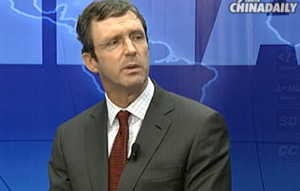A decisively positive outcome
Updated: 2013-11-22 10:34
By Giles Chance (China Daily Europe)
|
|||||||||||
Hard action across the board needed as China follows historic blueprint for change
Disappointing, a let-down, failing to deliver - these were the first reactions from the world press to the communique released at the end of the long-awaited Third Plenum of the 18th Communist Party of China Central Committee held from Nov 9 to 12.
Expectations around the world had been raised by a series of statements from top Chinese leaders promising an announcement of "unprecedented" reforms at the plenum. But markets recovered their poise as more details emerged about the Chinese government's economic reforms.
On Nov 15, the Hang Seng Index rose more than 3 percent, and the market continued its strong advance on Nov 18, the next trading day.
The direction in which the Chinese government is headed became evident early last year, with the publication of a report called "China 2030". The report, which provided the blueprint for China's reform program announced at the Third Plenum, was jointly authored by the Development Research Center of China's State Council and the Washington-based World Bank.
This was the first time that a major high-level economic report had involved major institutions from inside and outside China working together. It helped to ensure that the report's recommendations were in line with realities on the ground, as well as with Chinese and foreign perspectives.

The joint report, based on "the strong conviction that China has the potential to become a modern, harmonious, and creative high-income society by 2030", stated that, to reach this desirable objective, China must change its policy and institutional framework. The report proposed six strategic directions for China's development strategy: a reduced role for the state, with more competition; more innovation, linked to global research and development networks; green development as a growth opportunity; equality of opportunity and social protection through the improvement of social security; a stronger, better-based tax system; and more global integration.
The government's role should change from providing goods and services directly to society toward providing systems, rules and policies that increase production efficiency, promote competition, facilitate specialization, enhance the efficiency of resource allocation, protect the environment and reduce risks and uncertainties.
The report recommended further reforms of the state-owned sector, which consumes around 50 percent of the resources in China but employs only 13 percent of the labor force and produces less than 20 percent of the output.
In the financial sector, it stated, China needed to fully commercialize the banking sector, and allow market forces to set interest rates. Capital markets should be deepened, the legal and supervisory infrastructure needed strengthening to ensure financial stability, and credible foundations built to enable China's full participation in international capital markets.
In the labor market, China had to reform the hukou (housing registration) system to ensure that by 2030 workers can move in response to market signals. It also needed to increase labor participation rates and use social security instruments (pensions, health, and unemployment insurance) that can be taken from one job to another, nationwide.
Rural land markets needed to be overhauled to protect farmers' rights and increase the efficiency of land use. China had to encourage and strengthen innovation, and become "greener" by encouraging new investments in a range of cleaner and more efficient technologies.
As China's present taxation system is relatively weak, new ways of raising government revenue, particularly through value-added or other indirect taxes, needed to be introduced, especially for local governments who have been saddled with excessive expenditure problems.
Finally, the China 2030 report stated the country needed to continue to integrate into the world economy to increase its efficiency and prosperity via deepening trade and investment interaction with other economies.
Because so much time and effort has been spent on researching and thinking through the reform package, the main problem before the Chinese government now is not what to do, but how to do it. Implementing profound social and economic change can bring great benefit, but is hard, because change affects powerful interest groups.
In China, many of the forces who resist serious change lie in local and central government, and in the government-controlled enterprises, including the large banks. Moving away from a government-controlled system which operates through large, monopolistic, state-owned institutions to embrace a market-driven system populated by a much wider range of institutions (foreign, private as well as state-owned) will require the compliance of large numbers of senior officials.
Successful change introduced by a succession of top leaders since 1949 in China has been carried out through the Party. It is for this reason that, since his election to the top Party post a year ago, President Xi Jinping has pushed forward.
The communique published after the end of the Third Plenum announced the creation of two new state-level institutions: one to co-ordinate and strengthen control over state security, and the other to research, plan and oversee the changes in Chinese institutions that will help the country to improve economic efficiency and reach its goal of being a high-income country.
The creation of an institution to oversee the reform process is consistent with the need to push change in China through the effective, centralized system that the Party controls. Some foreign commentators expressed disappointment that the reform plan mentioned nothing about political change. But the economic and social changes which the Plenum introduced need strong central leadership to push it through.
In addition to control from above, support from below, from the people, is vital for the reform process to be successful in China. For this reason, the government needs to carefully consider the order in which it introduces key reforms, to ensure that it gains popular support early on for its reform process.
High on the list is the decision to allow local governments to relax the family planning rule. Demographics work in periods of decades, not years, so the impact of larger family sizes on Chinese demographics will not be felt soon. But the decision will help arrest the decline in China's population scheduled to start in about 2020, and mitigate the impact of a rapidly increasing population of retired workers projected to reach 350 million by 2025.
While rising costs may prevent some Chinese couples from having more children, allowing mothers to have an extra child is a popular move because it allows greater choice about an aspect of life near to the heart of every Chinese person - the family.
Introducing the market into economic and social life will be a long-term process. China's entry to the World Trade Organization in 2001 was the step that brought rapid increases in prosperity by opening it up to the world economy. In the same way, a decision to bring the Chinese currency toward full convertibility will encourage greater flows of capital into and out of China, strengthening the flow of new ideas and technologies into China, and helping accelerate the process of reform.
Financial reform lies at the heart of China's reform process, starting with market-determined interest rates, and competition involving foreign banks operating on equal terms with Chinese ones. Increased competition in the banking sector will impact on state-owned companies that presently obtain their finance at preferential rates from state-owned banks. Some state-owned companies will adapt to increased competition, and flourish; others may not, and will have to be merged or liquidated.
The Third Plenum will probably be remembered as a key moment not just in modern Chinese history but also - with China providing 15 percent of international economic output and 40 percent of the growth - in world history too.
The author is a visiting professor at Guanghua School of Management, Peking University. The views do not necessarily reflect those of China Daily.

(China Daily European Weekly 11/22/2013 page6)
Today's Top News
Premier Li heads west on opening-up tour
Deal reached in Iranian nuke talks
Roar of the East being heard
New air zone in line with practice
UN talks agree on major principles for climate pact
China maps out air defense ID zone
Nokia has 'phab' plan for Chinese mobile market
Newtown investigation report to be released
Hot Topics
Lunar probe , China growth forecasts, Emission rules get tougher, China seen through 'colored lens', International board,
Editor's Picks

|

|

|

|

|

|





